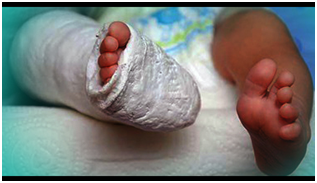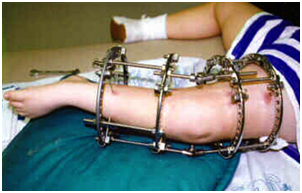Treatment of Arthrogryposis

Introduction to Arthrogryposis
June 21, 2021
Causes of shoulder pain in teens and adolescent kids
July 15, 2021Treatment for arthrogryposis differs from patient to patient. The major factors being symptoms, severity, and age of the patient. It is important to have a holistic treatment protocol for the patient’s overall functional improvement and independent living.
The treatment could be in a combined surgical and non-surgical options depending upon the diagnosis and clinical evaluation.
Non-surgical Treatment
Neuro NICU care and treatment is essential for newborn babies who display signs related to the complications in their nervous system on account of their arthrogryposis condition.
Other Non-surgical Treatment options
Physical therapy is the mainstay of arthrogryposis treatment. It begins soon after birth. Physical therapists suggest stretches and exercises that improve the range of motion and muscle strength, enabling better mobility of the patient. Parents and caregivers, too, have to follow the suggested exercise protocol with the patient at home.
Physical therapists also guide and suggest ways to make the patient crawl, sit, roll, stand, walk and even play to improvise the motor skills. Also, suggestions can include use of assisted devices such as a walker, wheelchair, and so on to make the patient mobile.
Occupational therapy

This therapy involves gearing the patient on how to eat, get dressed, move around, and use assisted walking devices. These therapy sessions also teach the patient writing skills and using adaptive devices.
Use of splints and casts

Each patient requires different casts or splints at varying times. The treating therapists and the doctors decide the decision of how to use them, when to use them, and their frequency.
Splints and casts provide the much-needed support to the joints, ensure they are well stretched, and help the child move around with confidence.
Surgical Treatment of Arthrogryposis
Arthrogryposis condition relates to contractures in more than one joint of the body. Hence, surgical correction is considered a viable option, especially if multiple corrections are required either in the upper or lower limb extremities or both.
Surgeries performed include correction of hip dislocation, club feet, knee contractures, and deformities in the spine or upper limbs. Hence, the chances of multiple surgeries are very considered for proper rehabilitation of the patient.
As mentioned earlier, the treatment of arthrogryposis is a long and comprehensive one which could include multiple surgeries –
Typically, surgical correction is necessary for the correction of clubfeet, knee contractures, hip dislocations, or in upper limbs to correct deformities that limit or interferes with function.
Feet
Most of the arthrogryposis patients have clubfoot deformity, which is also known as rigid talipes equinovarus deformity. The patient’s feet turn inward and downward, and hence the focus of the treatment is to provide the patient with plantigrade, braceable feet.
In the first three months, casting and stretching is done to correct deformity, followed by extensive medial and lateral release and lastly long casting and bracing. However, the patient may develop clubfeet again, which is then treated by a lateral column shortenings (Lichtblau procedures) or talectomy and other bony procedures.
In older patients without prior treatment, the surgeon recommends a combination of soft-tissue releases and bony procedures. On the other hand, a patient with a matured deformed foot is treated with triple arthrodesis with good outcomes, especially in providing them with plantigrade foot.
In a skeletally mature deformed foot, triple arthrodesis often gives a satisfactory plantigrade foot. In an older child with no previous treatment, a combination of soft-tissue releases and bony procedures may be indicated.
Knees

In the case of patients with affected knee conditions due to arthrogryposis, the treatment is focused on making the patient walk independently without support. Mild contracture of the knees is treating with splinting and passive stretching. Usually, soft contracture of the knees does not affect the patient’s ability to walk independently.
Moderate contractures in the range of 20-60° need soft-tissue releases along with posterior capsulotomy of the knee joint and followed by long-term bracing.
Lastly, a patient with severe contractures i.e.> 60° are treated with femoral shortening and soft-tissue releases in order to release the tension on the neurovascular structures behind the knee. Also, knee disarticulation is considered if the older child has severe flexion deformity.
Passive stretching and splinting is advised to patients with extension deformities of the knee, such as recurvatum or even anterior dislocation.
If the patient is less than six months old, quadricepsplasty is performed for best outcomes. Also, it is advisable to correct the deformities of the knee before moving in to correct hip dislocation for facilitating hip reduction.
Hips
Treating hips through surgical procedure is done after the knees and the foot conditions have been corrected. Also, open reduction surgery is suggested if the patient with bilateral hip dislocation or extremely mobile hips.
If the patient has a unilateral hip dislocation, then it is advisable to perform a reduction to prevent scoliosis and pelvic obliquity.
If the patient is less than a year old, hip surgery is advisable to ensure he or she has to be made capable of walking independently.
Treating Hip flexion conditions
Mild hip flexion contracture of <35° is acceptable but if it exceeds >35°, a soft tissue release becomes essential.
A bilateral hip dislocation greater than 35° with flexion contracture should be treated with stretching and soft-tissue releases but not with reduction.
Unilateral hip dislocation requires reduction to avoid pelvic obliquity and scoliosis.
Upper extremities
The focus of treating the upper extremities is to make the entire extremity functional. The treatment of the upper extremity begins when the child turns 5-6 years.
Elbows –
Elbow correction is essential before seeking to correct the deformed wrist. The surgeon focuses on building up the passive or active flexion capability of the elbow through capsulotomy, a triceps transfer, or a pectoralis major transfer or providing motor power.
Wrists
If the patient’s wrist deformity is associated with flexion and ulnar deviation, the scope of treatment includes stretching and splinting.
A severely deformed wrist is treated by performing a proximal row corpectomy with or without fusion. Also, a trapezoid wedge excision is considered as it improves dorsiflexion.
Fingers
Passive stretching and splinting are recommended to treat minimal to moderate flexion deformities. Soft tissue releases and proximal interphalangeal joint fusions are recommended to treat extreme deformities of the fingers. In case of, correction of thumb-in-palm deformities is done for providing opposition-improved grasp
Spine
Nearly one-third of arthrogryposis patients have scoliosis, which is a progressive condition, and the spine is likely to develop into a rigid C-shaped curve. If the C-shaped curve exceeds 35° spinal fusion and instrumentation is given a serious thought.



